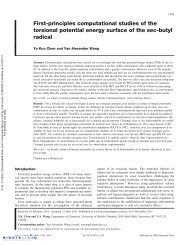Electrospray ionization source geometry for mass spectrometry: past ...
Electrospray ionization source geometry for mass spectrometry: past ...
Electrospray ionization source geometry for mass spectrometry: past ...
Create successful ePaper yourself
Turn your PDF publications into a flip-book with our unique Google optimized e-Paper software.
Trends Trends in Analytical Chemistry, Vol. 25, No. 3, 2006<br />
<strong>for</strong> further ef<strong>for</strong>ts in high throughput parallel analysis,<br />
Kassel’s system required knowledge of the particular<br />
analyte that each sprayer was generating. Dual ESI<br />
<strong>source</strong>s have also been used to introduce an internal<br />
calibration solution separately from the analyte solution<br />
[93–96]. This configuration provides benefits compared<br />
with a single solution containing both analyte and<br />
calibrant because it avoids preferential <strong>ionization</strong>.<br />
In 1999, Kassel et al. [97] and De Biassi et al. [98]<br />
described indexed multiple sprayer systems that allow<br />
sequential sampling of each spray by a <strong>mass</strong> spectrometer,<br />
thus making it possible to identify ions from their<br />
respective eluent stream.<br />
Currently, publications in which fast LC-MS analyses<br />
of samples are discussed indicate that the Waters/<br />
Micro<strong>mass</strong> multiplexed ESI <strong>source</strong> (MUX) is the most<br />
commonly used <strong>for</strong> the analysis of multiple LC eluent<br />
streams [99–101]. Tiller’s 2003 review paper provides<br />
useful references regarding biological applications using<br />
the MUX system as well as other types of parallel analysis<br />
[102]. The MUX system attaches to the Zspray<br />
<strong>source</strong> of the <strong>mass</strong> spectrometer and is fitted with either<br />
four or eight channels. As a rotating aperture allows<br />
only one spray at a time to reach the sampling cone,<br />
spectra of compounds eluting from individual separation<br />
columns can be quickly acquired.<br />
However, a significant problem with MUX-type<br />
systems is a decrease in sensitivity of approximately<br />
three-fold at high flows [103]. Yang et al. attributed the<br />
drop in sensitivity to several reasons, such as difficulty in<br />
optimizing sprayer position and lower desolvation<br />
efficiency due to large amounts of solvent introduced<br />
into the <strong>source</strong> in combination with a desolvation gas<br />
that was counter-current relative to the spray instead of<br />
the traditional coaxial flow. The sensitivity decrease is<br />
expected to be larger <strong>for</strong> nanoflow operation, where<br />
sprayer position can be more critical.<br />
In 2002, Schneider et al. [104] developed an alternative<br />
multiple sprayer system that appeared to solve the sensitivity<br />
problem. By installing an atmospheric pressure ion<br />
lens [76,105] on each sprayer of a dual sprayer and a four<br />
sprayer ESI <strong>source</strong>, they were able to maintain high sensitivity<br />
by optimizing the applied lens potential as well as<br />
sprayer position. An additional advantage of the system<br />
was that sprayers could be enabled or disabled by<br />
changing the lens potential, potentially a faster method<br />
than using mechanical devices.<br />
7. Recent developments in ESI <strong>source</strong>s<br />
The quest <strong>for</strong> a superior <strong>source</strong> design capable of effectively<br />
focusing more of the electrospray generated ion<br />
cloud through the sampling aperture of the instrument is<br />
still on going. Due to gas phase collisions occurring<br />
under atmospheric pressure conditions and space charge<br />
252 http://www.elsevier.com/locate/trac<br />
effects, only a small percentage of the spray plume is<br />
actually sampled. There is still significant room <strong>for</strong><br />
improvement in ion sampling efficiency.<br />
7.1. High velocity nebulizers<br />
One approach developed by Zhou et al. [106] involved<br />
installing an industrial air amplifier between the electrospray<br />
probe and the sampling orifice. The concentric,<br />
high velocity gas flow was meant to control the expansion<br />
of the spray plume as well as assist in the desolvation<br />
of ions. In addition, focusing of ions could be<br />
achieved by applying an optimized voltage of up to 3 kV<br />
onto the amplifier. Thus, when both the air amplifier and<br />
the high voltage were used, Zhou’s ion <strong>source</strong> configuration<br />
seemed to provide some improvement in ionsampling<br />
efficiency. Suppression of background chemical<br />
noise was also observed.<br />
7.2. Improved nanoflow configurations<br />
Schneider et al. developed a novel interface <strong>for</strong> nanoflow<br />
ESI (Fig. 10) that provides two separate atmospheric<br />
pressure regions <strong>for</strong> droplet desolvation as well as two<br />
regions <strong>for</strong> removing unwanted particles [107].<br />
The first desolvation stage makes use of the traditional<br />
counter-current gas to eliminate neutral particles and<br />
solvent. Next, charged particles, ions and gas travel<br />
through the heated laminar flow chamber, where additional<br />
desolvation takes place at optimal temperature.<br />
Once they reach the particle discriminator area, ions are<br />
carried by the gas streamlines through the discriminator<br />
space and into the sampling orifice, while large charged<br />
particles with high momentum escape from the gas<br />
streamline trajectory under the influence of the strong<br />
electric field. This <strong>source</strong> design provided improved signal<br />
and ion current stability <strong>for</strong> flow rates from a few nL/<br />
min up to 1 lL/min as well as improved per<strong>for</strong>mance <strong>for</strong><br />
gradient elution nanoLC-MS in both positive-ion and<br />
negative ion mode [108].<br />
7.3. Desorption electrospray <strong>ionization</strong><br />
Cooks and co-workers recently described a new method<br />
of <strong>ionization</strong> in which analytes are desorbed from<br />
surfaces by nebulizing the charged droplets of an<br />
electrospray plume at a surface [109]. This technique is<br />
referred to as desorption electrospray <strong>ionization</strong> (DESI).<br />
The exact mechanism of ion <strong>for</strong>mation in DESI is not<br />
well understood, although the technique has been<br />
successfully used <strong>for</strong> analyzing a number of samples,<br />
including pills and TLC plates [110]. Efficient sampling of<br />
desorbed ions requires careful optimization of the angles<br />
and the spacings between the surface, the electrospray<br />
emitter, and the <strong>mass</strong> spectrometer inlet.<br />
7.4. Coupling ESI to micro-analytical systems<br />
In the rapidly expanding area of microchip chemical<br />
analysis, currently known as ‘‘Micro-Total Analysis



